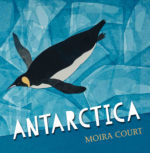Fremantle Press picture book author and illustrator Moira Court reveals 10 fascinating facts about Antarctica and its animals to explore in the classroom

Moira Court’s stunning new picture book Antarctica helps pre-primary and early primary school readers discover some of the amazing animals and birds that exist on this chilly continent.
Here Moira shares 10 interesting facts about Antarctica she uncovered while researching the book. We challenge you and your students to see what else you can discover!
1. Antarctica is MASSIVE. It’s around 14 million square kilometres in size, which is roughly the same as the United States and Mexico put together.
2. Believe it or not, Antarctica is a desert. A desert isn’t just a place with sand and heat; the actual of definition of desert is just a very dry place with very little rain or snowfall. Antarctica has hardly any rain or snow because it’s so cold, which is why it’s considered a desert.
3. There are six south poles. Yep, you heard right. The geographic south pole is the one that is directly opposite the geographic north pole and is the one you’d see on a map. The south pole of rotation is the point at which the earth spins on its axis; this is not the same as the geographic south pole since the Earth actually wobbles on its axis, meaning that the south pole of rotation (or instantaneous South Pole) is constantly in motion. The celestial south pole is where the earth’s axis intersects the night sky, while the south magnetic pole marks the southerly point of the Earth’s magnetic field. Number five is the southern pole of inaccessibility, which is the point that is the furthest from the sea, and, last but not least, the south pole of cold (brrr) is simply the place with the lowest recorded air temperatures
4. Icebergs can be many colours. They’re mostly white, but some are blue because they have fewer bubbles in them and so refract light differently, some are green and are made from frozen seawater, and some are even stripy because they’re made from a combination of all three.
5. Just like humans have different hair colours, animals can have differently coloured features too. The bottom part of the emperor penguin’s beak (called the lower mandible) can be orange, pink or lilac.
6. Elephant seals can swim to depths of two kilometres.
7. Snow petrels spray stinky stomach oils out of their mouths to defend themselves against predators.
8. Krill (small ocean crustaceans) are bioluminescent, which means they glow a yellow-green colour – underwater and in the dark due to natural chemicals in their body.
9. Icefish have a natural antifreeze in their translucent blood, which means that they can survive in sub-zero temperatures without getting frozen!
10. The anatomy of starfish is incredibly interesting and varies between tropical and Antarctic varieties.
Antarctica by Moira Court will be published on 1 November. Teaching notes are available online at www.fremantlepress.com.au or can be downloaded here.






